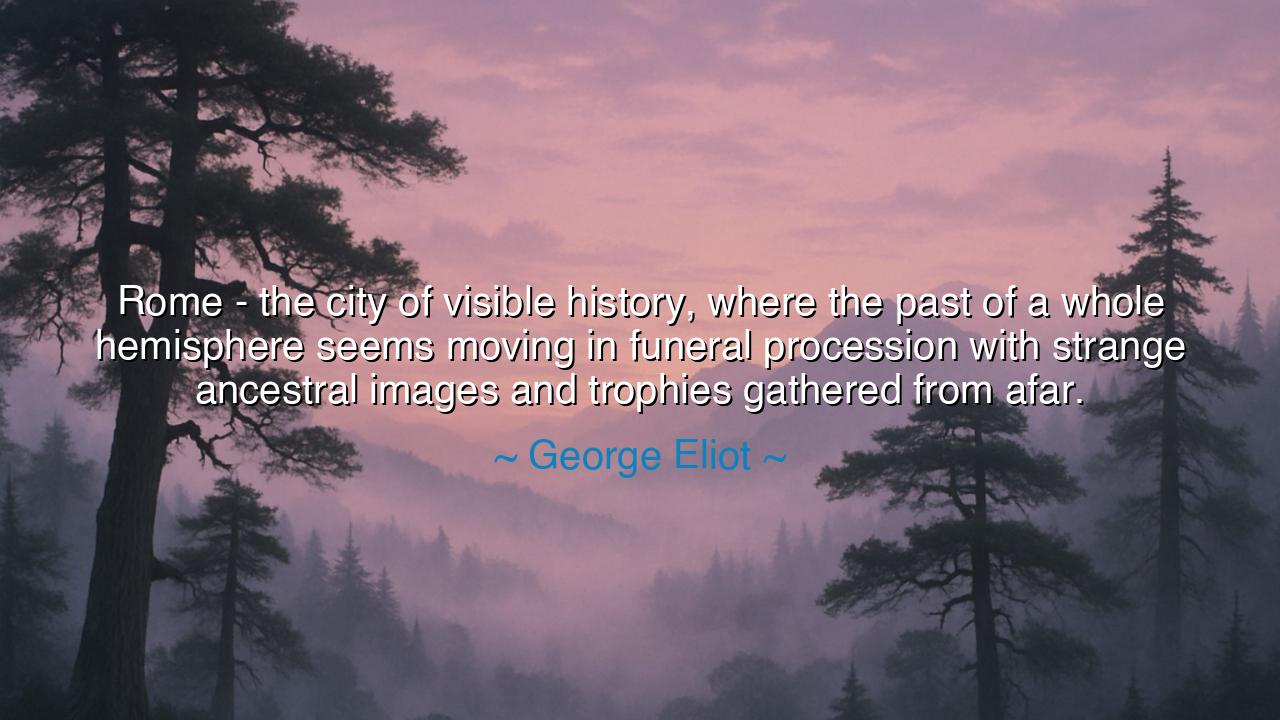
Rome - the city of visible history, where the past of a whole
Rome - the city of visible history, where the past of a whole hemisphere seems moving in funeral procession with strange ancestral images and trophies gathered from afar.






“Rome — the city of visible history, where the past of a whole hemisphere seems moving in funeral procession with strange ancestral images and trophies gathered from afar.” Thus wrote George Eliot, the great voice of Victorian wisdom, whose gaze pierced not only the present but the deep strata of time. In these words, she captures the majesty and melancholy of Rome, that eternal city where the stones themselves seem alive with memory. To walk its streets, she tells us, is not merely to see the relics of an empire, but to witness a funeral procession of history — a pageant of civilizations long gone, carrying with them the triumphs and tragedies of an entire hemisphere. Her words are not cold observation; they are reverence — a hymn to the endurance and fragility of human greatness.
The origin of this reflection lies in Eliot’s own pilgrimage to Rome in the nineteenth century, a time when scholars and poets from all over Europe journeyed there as if to Mecca. For in Rome, history was not confined to books or imagination; it was visible, carved into the marble, echoed in the arches, and whispered through the ruins. The Colosseum, where emperors once feasted on spectacle and blood; the Forum, where senators debated the fate of nations; the Pantheon, whose dome still defies the centuries — all stood as monuments to what humanity can build and what it can destroy. To Eliot, Rome was not merely a city; it was a mirror of civilization, reflecting both its glory and its decay.
When she speaks of a funeral procession, her meaning is profound. For Rome, though filled with the remnants of power, is not a city of living empires but of fallen ones. Its columns and statues are like mourners carrying the images of their ancestors, their faces eroded but their dignity intact. The trophies gathered from afar — the obelisks of Egypt, the marbles of Greece, the spoils of Carthage — tell the story of conquest, yet they also stand as silent witnesses to the cost of ambition. Time, Eliot reminds us, turns every victory into dust. The very city that once ruled the world now walks behind its own legacy, solemnly bearing the weight of its past.
And yet, in that solemnity lies something transcendent. For Rome’s ruins are not only symbols of death, but of continuity — of the eternal dialogue between what was and what remains. Every stone testifies that human creation, though mortal, seeks immortality. When the empire fell, its language, its laws, its architecture, its art did not perish — they flowed onward into the veins of Europe, shaping the very world we live in. Thus, the funeral procession of Rome is not a dirge but a transformation — the passing of the old into the new, the handing down of torches from the dead to the living. Eliot, ever the moral philosopher, saw in Rome’s grandeur both a warning and a promise: that greatness is impermanent, but meaning endures.
Consider how, centuries later, Napoleon Bonaparte stood among the same ruins, dreaming not of mourning the past but of reviving it. He called himself a modern Caesar and sought to rebuild an empire to rival Rome’s. Yet, like the emperors he admired, he too fell — his victories turned to ashes, his monuments left for history’s judgment. This is the eternal pattern that Rome embodies: the rise, the glory, the fall, and the remembrance. Every ruler who walks among her ruins must feel the breath of humility on his neck, for the stones of Rome whisper, “All this has happened before, and will happen again.”
In George Eliot’s time, and in ours, Rome still speaks to the human heart. Its visible history awakens something sacred within us — the awareness that we are both fleeting and eternal. We live in the shadow of those who came before, and our own deeds will one day join the procession of time. But this need not fill us with despair; it should awaken reverence. For to know that we are part of the long story of humanity is to live with purpose, to create not for our own glory, but for the generations who will walk after us, as we walk now among the ruins of Rome.
So, my child of tomorrow, heed the wisdom hidden in Eliot’s words. When you stand before the relics of the past — whether a crumbling temple or an old photograph — remember that they are not merely dead things. They are echoes of the living, fragments of souls who dreamed, built, and believed. Learn from them. Let the ruins teach you both pride and humility: pride in the greatness humanity can achieve, and humility in knowing that all greatness must one day yield to time. Build your own monuments — not of stone, but of compassion, truth, and art — for these are the only trophies that time cannot carry away.
For in the end, Rome stands as a parable of mankind itself — proud, wounded, immortal in memory. The city of visible history reminds us that to live well is to live as part of the grand procession, walking not as conquerors nor mourners, but as keepers of the flame. And as long as we remember, as long as we honor the stories of those who came before, the funeral procession becomes something more than sorrow — it becomes a march of eternity, the endless heartbeat of human history itself.






AAdministratorAdministrator
Welcome, honored guests. Please leave a comment, we will respond soon